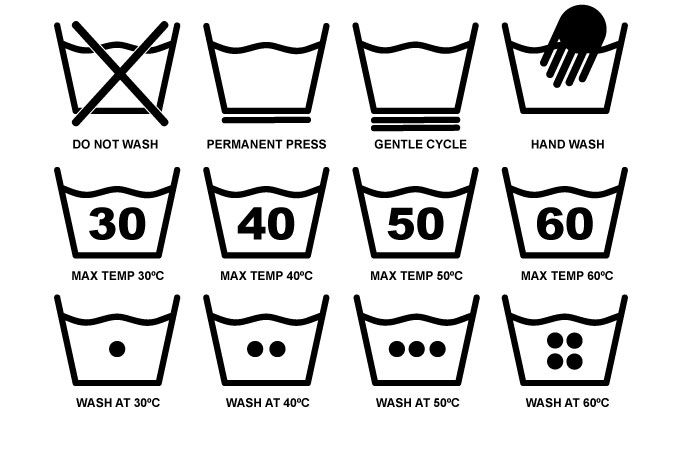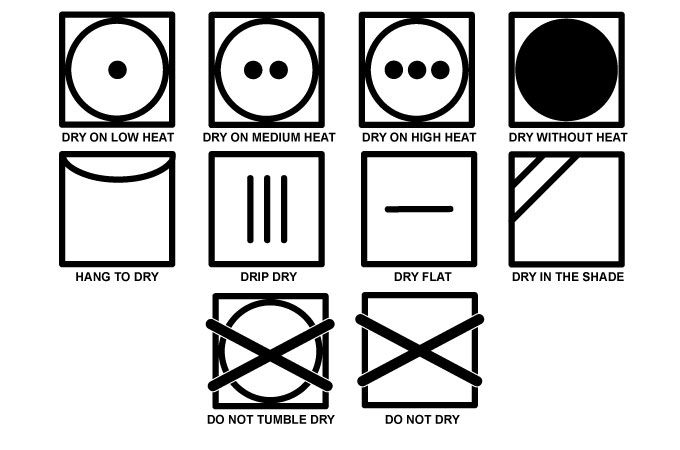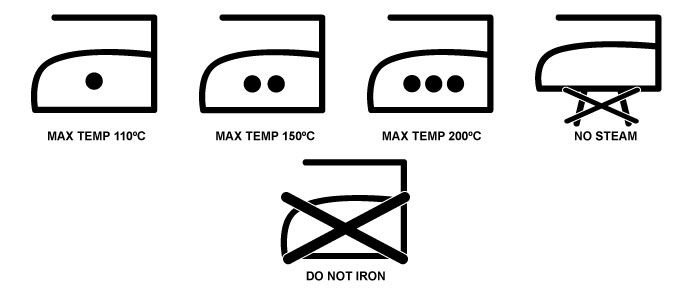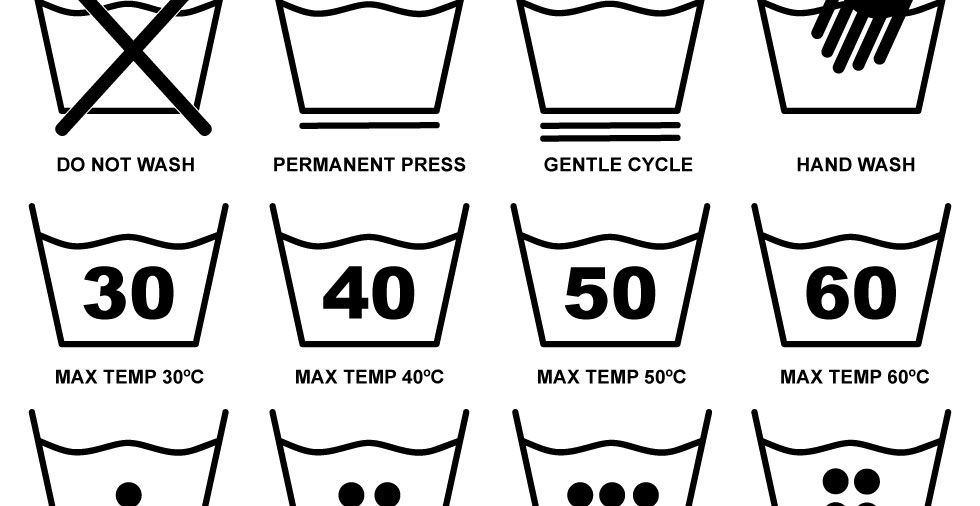Laundry symbols can be pretty confusing - they're almost like another language in themselves! And if you want to avoid laundry mishaps, it's a language you should get clued-up on.
If you're confused about what you can clean in the washing machine, that's just half the problem! Whilst putting a cotton top in at 40ºC instead of 30 might not be a big deal, wools and silks are a different story.
Today we're talking you through the mystery meaning behind washing labels so you can avoid ever ruining your clothes again. As well as explaining each mysterious symbol individually, we also have a printable washing label guide for you to keep so you'll always have knowledge on hand.
Ready to get washing? Check your tags and let's get started!
Editor's Note: This article was originally posted in January 2019 and has been completely revamped and updated for accuracy and comprehensiveness in July 2019.
Washing symbols

The symbol shown above indicated an instruction to do with the washing process itself. There are many variations of this washing machine symbol to give you more details on exactly how to wash your items for best results, including what temperature, method and cycle to use.

Terminology
Do not wash - Items with this symbol should not be washed at home. Instead, they will need to be dry cleaned - we'll discuss the corresponding symbols in detail later on.
Permanent press - Permanent press items are those that have been treated to prevent wrinkles and any shape-distortion. They don't usually need to be ironed.
Gentle cycle - Garments that require a gentle cycle are usually made from delicate fabrics such as wool or silk, or those that have details that could be damaged by a normal cycle.
Hand wash - Clothes marked with a hand wash symbol should never be put in the washing machine. Instead, wash them by hand in a small basin with some special detergent (those intended for hand wash use are normally much milder). You might find materials like linen and viscose can shrink if machine washed. Take a look at our favourite laundry detergent alternatives.
Dots - each dot signifies a different temperature:
1 = 30ºC
2 = 40ºC
3 = 50ºC
4 = 60ºC
That's not all you need to know, though. If you're superstitious, you should check when it's bad luck to wash clothes.
Tumble dry symbols

The basic symbol for tumble drying is a square with a circle inside. There are variations to the symbol which tell you exactly how to dry your clothes and also what temperature to use to ensure they do not fade or worse, shrink, in the wash.
The laundry symbol of a square without the accompanying circle signifies drying without the use of a tumble dryer, and again, has several variations shown below.

TOP TIP: Now you know if you can put your garment in the tumble dryer, find out how much it costs to run.
Terminology
Drip dry -synthetic garments are usually ok to be hung up straight out of the wash, even when dripping wet. They usually dry without wrinkles when hung up to 'drip-dry' and therefore don't need ironing either.
Hang to dry - items that are marked with the 'hang to dry' symbol can be popped over a drying rack or hung up to dry on hangers.
Dry flat - garments that need to be dried flat are usually relatively heavy, and therefore shouldn't be hung in case the weight alters their shape. Place on flat surfaces or flat across drying racks to dry.
Dots - as before, dots signify different temperatures:
1 = low heat
2 = medium heat
3 = high heat
Ironing symbols

Ever burnt a hole through a piece of clothing? Getting clued up on the different ironing symbols will ensure it never happens again. The symbol above stands for ironing and variations on it help you determine what temperature or setting to use.

Terminology
No steam - Some materials don't react well to steam, or to put it another way, the combination of water and heat. If you see this label, be sure to turn off the steam function on your iron before ironing.
Dry cleaning symbols

We've arrived - the dreaded dry clean only symbol! This one means your garment could be damaged in the wash and should be laundered professionally. It may be more expensive, but trust us, it's not worth risking.

Terminology
Letters - dry cleaning symbols with letters insides are there to tell the professionals how to treat the garment, so you don't need to pay too much attention to these.
How to do dry cleaning at home
If a garment has a dry clean symbol on the label, do you really have to pay out every time it needs washing? Watch this video to find out more!
Next up, learn how to get chocolate out of clothes.
Q&A
What does the cross symbol mean?
A cross on any laundry symbol means that you should not carry out the depicted action. For example, a circle with a cross in it means do not dry clean.
What does 40 mean for washing clothes?
40 refers to the temperature you should wash your clothes at. Your machine should have a setting for a 40-degree wash.
What does wash separately mean?
If a garment is labelled with "wash separately", it's because the fabric is highly pigmented or it could cause damage to other delicate fabrics. You should wash these items singularly because the colour could bleed, staining your other clothes. This is not the most eco-friendly option, so you might want to hand wash the garment instead.
What's the difference between washing clothes in cold water over hot water?
The temperature you use to wash your clothes could vary for a number of reasons. Cold water is best for washing stains like blood and sweat - these stains will only set further into the fabric if you wash them on a hot setting.
Hot water is better for sanitising fabrics - some will use higher temperatures to kill germs on towels and bedding or to get underwear cleaner. Hot water can damage certain fabrics and cause them to shrink.
Keep an eye out for laundry symbols on all your clothes to prevent any mishaps! What's the worst washing accident you've ever had? Let us know in the comments below!


Hi Steph - Years ago, when I had my very first washing machine, I accidently put my husband's beautiful cable-knit sweater on at 90. It came out so small that it fitted our daughter's teddybear! Of course, I had to buy him a new sweater.
What a funny story! I bet the bear looked very fashionable. Thanks for getting in touch.
Hi. my worst washing machine accident was actually my elder sister. Mum had just taken delivery of a brand new Hoover "Keymatic" machine, and My sister decided to use it to wash her new jeans. When she asked mum for the washing powder, Mum replied that it was in the cupboard under the sink. My sister then filled the machine with "Polyfilla". the machine ended up as a solid block of plaster!!!!! Luckily the maufacturer saw the funny side, and the machine was replaced F.O.C. My sister was never allowd near the new one....
That's a great story, Stephen!
When I was first married I decided to boil some cotton hankies. Not a problem until I decided to put a yellow duster in as well to make sure it was germ free. All of our hankies turned a dirty yellow colour and it took months before I managed to get them white again.
We're impressed that you managed to get them white again, Sylvia!
Hi. My main problem is sorting clothes and worrying that some garments may run. We all seem to have so much more clothing nowadays so the washing machine is in constant use and there are so many different fabrics to deal with! I find using Colour Catchers reassures and makes things easier for me. Also I have a question: is it OK to wash trainers in the machine and at what temperature?
Hi Dee! I love using Colour catchers too, even if just for peace of mind. You can wash trainers in the washing machine, but it can ruin them so be careful. Your best bet is to test the method on a cheap pair of trainers first. Start by removing the laces and scrubbing away any surface dirt. Remove the laces and then place the trainers inside of a pillowcase or a mesh bag. Put them in the washing machine along with a couple of towels. The towels will reduce noise and protect your shoes. I'd suggest washing on a hand wash setting or 30°C.
i remember when they had the ºc then a number above that e.g. 40ºc with a 5 above the uncompleted square with wavy water meant non-colourfast cotton wash to be used
Thanks for sharing, Michael!
nice
Thanks, Khayrul!
I have never seen the "Do not Dry" on any clothes. What does that even mean? Wear wet?! I guess not. May associated with other ways of cleaning?
"Do Not Dry" on clothes means avoiding using a dryer machine for drying the clothes after washing. Instead, the clothes should be air-dried or dried using other methods such as laying flat or hanging. This is usually indicated for delicate fabrics or special features, such as prints that may be damaged or fade in a dryer.
I have a collection of Edwardian linens...pillowcases, tablecloths, many with handmade lace edges or inserts. Where I used to live, the articles would wash in the machine, dry nicely and a quick iron...and we are good to go. Moved here to a hard water area, and some of my pillowcases were ....grey. Stark difference in colour between the ones unused from my former home. I phoned the care line of a detergent producer....and was asked "What does the care label say". Just have to laugh. 100 year old linens dont have care labels. I have resorted to old fashioned methods. Line dried in sun sorts it.... With hugs for those that need, socially distanced, Stay safe
That's a great story!
My daughter, who was about 11 or 12 decided to do me a favor and wash and dry my favorite dry clean only outfit. When it was finished, it was soooo small , too small for her even!!!
Oh dear!
Thank you for everything .
You're welcome!